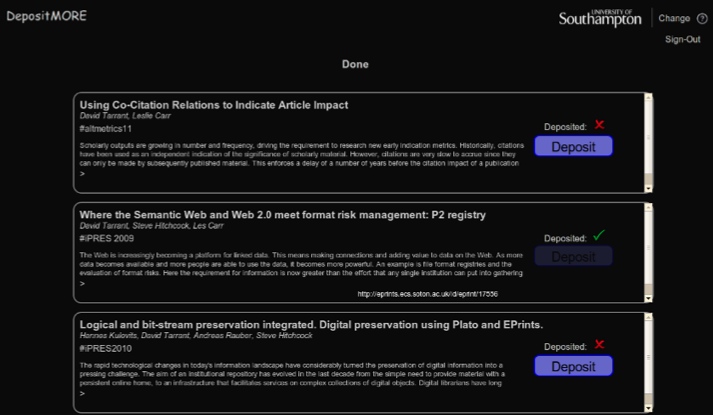DepositMO 2, Spiderman 3, Scream 4? There’s a reason JISC doesn’t do sequels, and not just because it isn’t in the business of funding films. And there’s a reason this project is DepositMOre and not DepositMO 2: it’s in the call.
Where DepositMO developed new deposit tools, DepositMOre is intended to be about applying those tools to test if they can result in a measurable increase in content for real repositories – within 6 months – because that is what the JISC call for projects specified. We are learning early in this work that in the era of ‘big data’ institutions are identifying eligible content by their researchers in external sources and finding they need help to import this content to their repositories, that is, the deposit tools follow the content rather than the other way round. A follow-on project, but with a twist, not just more of the same.

EasyChair deposit tool: identifying content from the EasyChair conference system with a one-click button for deposit in a repository
The tools developed in DepositMO, such as the Word Add-in, although visionary and original, are intended to support deposit of newly created content. Since we don’t expect to be able to stimulate an orgy of new research writing in 6 months specifically as a result of this project, the more pragmatic approach is to try and identify existing content that should be in a repository but isn’t. This sort of approach – finding the ‘low hanging fruit‘ – is hardly new to repositories.
So the emphasis in DepositMOre is on tools for content discovery, of extant content that should have a copy in a repository, and the means of simplifying the heavy lifting – and thus saving time – of deposit .
If you read the project proposal you will find an example using the EasyChair conference system. EasyChair manages papers submitted to conferences. In many cases, conference proceedings are published, and once papers have been reviewed and selected then EasyChair has done its job. Not all papers are published, however, and many remain, unintentionally, exclusively in the EasyChair files, but these papers are searchable.
The aim of the DepositMOre EasyChair tool is to search the EasyChair corpus, and then check against the contents of a specified repository to find if a given paper has already been deposited there. As can be seen in the illustration above, if an EasyChair paper is not matched in the repository then a deposit button appears; when a match is found a green tick is placed against ‘Deposited’ and the deposit button is greyed out to prevent duplication. Metadata describing the paper is displayed for the author or repository administrator to decide whether to activate the deposit, and is used to populate the repository record for the selected paper deposit.
Combining EasyChair search and repository comparison search is important, if probably not infallible, for expediting deposit. It’s the time-saving feature that will be at the heart of DepositMOre tools offered to repositories.
A similar approach can be envisaged for another discovery service linking to academic papers, Microsoft Academic Search (MAS): find papers and perform a match against current repository content, with an option to deposit, again using a simple button. Why not Google Scholar (GS)? MAS has an API, which means you can perform machine-based searches and process and import the results to another service; GS does not currently support this.
Deposit tools that work with EasyChair or MAS or other services are likely to be made available in the EPrints Bazaar. That’s another change from DepositMO – at release tools will work with EPrints and not DSpace. That again is dictated by the pragmatics of the project’s short timescale and the need to work with real repositories. All our partners manage, or have access to, an EPrints repository.
The evolution of the project does not end there. Our initial meetings with partners have begun to point at extant content they have already identified, but which is not easy to import to their repositories. In this case the potential attractions for repository managers of a DepositMOre tool are less discovery and more location and heavy lifting (time saving). Examples uncovered so far include video sources for arts repositories, and large collections of structured image data for an archaeology partner.
So the target of the project becomes clearer – it’s foremost about partner repositories and content, and the tools should follow those leads. That is the big change from DepositMO.
In the next posts we will introduce our repository and content partners, and show how they are leading us towards the development of new deposit tools for specified content.


0 Responses
Stay in touch with the conversation, subscribe to the RSS feed for comments on this post.